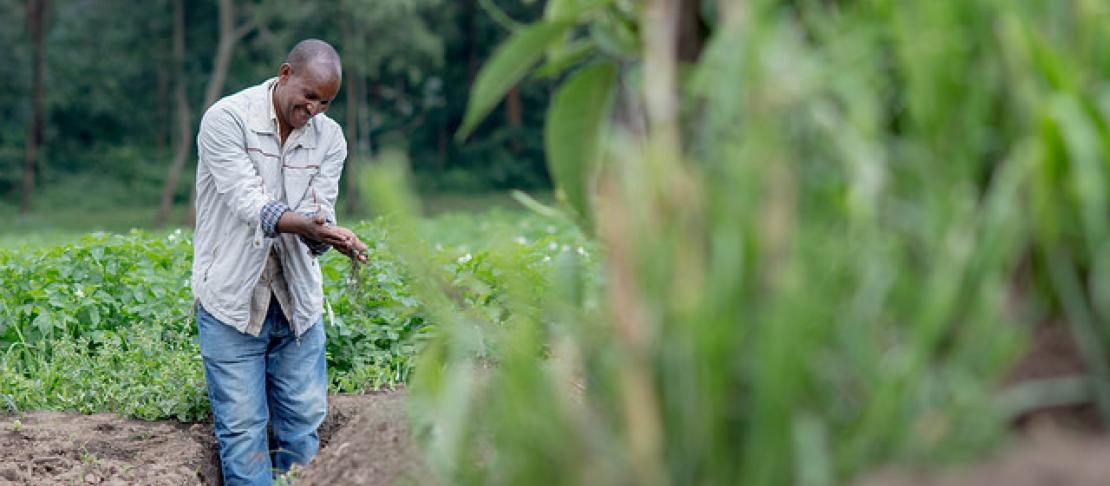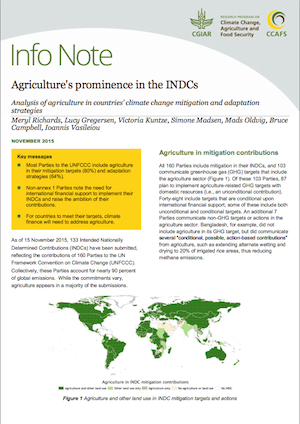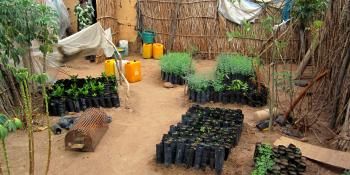New study exposes gap in global climate policy as countries commit to action on agriculture

COPENHAGEN (23rd November 2015) - A new analysis of the country-level climate plans submitted to the UN ahead of climate talks in Paris (COP21) has uncovered a huge appetite for technical assistance and climate finance for adaptation and mitigation strategies related to agriculture.
The brief, compiled by the CGIAR Research Program on Climate Change, Agriculture and Food Security shows that of the 160 Parties involved in COP21 that have submitted Intended Nationally Determined Contributions (INDCs):
- 80% have included agriculture in climate change mitigation targets or actions
- 64% have noted agriculture’s importance in climate adaptation strategies
- 36% refer to gender equality as an important goal of climate change action and policy
- 30% include mitigation targets in agriculture that are conditional on international financial support
Agriculture as a sector remains absent from the main draft text of the official United Nations climate negotiations, signalling a major disconnect between national-level planning and global-level policymaking.
download the brief

“Countries have made it clear that agriculture is a priority in their climate plans,” comments Bruce Campbell, Director of the CGIAR Program on Climate Change, Agriculture and Food Security (CCAFS). “The question is where the support to implement these plans will come from, as there has been exceptionally slow progress on these issues.”
INDCs submitted by countries in the developing world (in particular in sub-Saharan Africa), have indicated the need for financial assistance in order to achieve mitigation and adaptation goals related to agriculture. Costs range from USD 2.5 million for a programme to reduce slash and burn in the Central African Republic, to USD 1.8 billion to reduce emissions from rice, implement biodigesters for recycling waste and expand agroforestry systems in Senegal.
The study also shows that countries, particularly in the developing world, will need support accessing knowledge and technologies, especially those related to data collection and monitoring.
“This should serve as a wake-up call for climate negotiators, to make sure sufficient financing is released to support agriculture initiatives,” comments Meryl Richards, CCAFS Science Officer and lead author of the brief. “Countries are communicating that agriculture can have major co-benefits for climate change adaptation, economic growth and food security, and are seeking climate finance to support those plans.”
“These plans reflect what countries believe need to be done at the national level,” adds James Kinyangi, CCAFS East Africa Program Leader. “It is essential that the negotiations happening at the global level in Paris are aligned with what countries are demanding”.
CCAFS has been working for the past five years to deliver practical solutions to make farmers climate-resilient while also reducing their agricultural emissions. These include:
Providing weather-based index insurance: The Agricultural Insurance Company of India has created enhanced weather-index insurance products based on CCAFS research into the triggers that dictate when insurance payouts are made, such as rainfall levels. The improved data has helped cover farmers in areas where traditional agricultural insurance was not previously available and ensures that payouts are made promptly whenever farmers are hit by weather disasters. Reducing risks and stimulating investments should lead to lower emissions per unit of output.
Improving livestock productivity: Currently, livestock contributes to 47 – 55 per cent of agricultural greenhouse gas emissions. Responding to this, the International Livestock Research Institute and the World Agroforestry Center are testing measures appropriate to smallholders, such as better feed production and feeding practices, which can boost livestock productivity levels while also reducing emissions per kilogram protein or milk produced.
Saving water in rice production: Paddy rice contributes 9-10% of GHG emissions, yet draining irrigated fields for short periods can reduce methane by 30-40% while also reducing water needs by up to 30%, while producing the same or increased yields. The International Rice Research Institute (IRRI) is working with the government of Vietnam to map the suitability of these practices for different regions to assist their scaling up.
Reaching farmers with climate forecasts: In collaboration with AGRHYMET and the National Meteorological Services of several countries (e.g. Madagascar, Ethiopia, Tanzania), CCAFS is channelling climate information directly into farmers’ hands across Africa. By combining traditional and scientific knowledge, locally specific forecasts are tailored to meet farmers’ needs and delivered via mobile phones and radio broadcasts.
download the brief
Richards M, Gregersen L, Kuntze V, Madsen S, Oldvig M, Campbell B, Vasileiou I. 2015. Agriculture's prominence in the INDCs.
further reading
More information on what is working to make farmers climate-resilient while reducing emissions is available in the CCAFS brochure “Six Steps to Success: Lessons Learned from Five Years of CCAFS”. Indicators to guide countries on where investments are needed for climate adaptation and mitigation in agriculture can be found in the new info note: “Climate readiness indicators for agriculture”.


